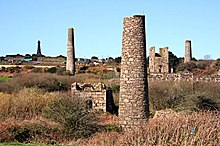West Cornwall Bryophytes
| Site of Special Scientific Interest | |

Disused buildings of the West Basset Stamps location
|
|
| Area of Search | Cornwall |
|---|---|
| Grid reference | SW661407 |
| Coordinates | 50°13′13″N 5°16′47″W / 50.2204°N 5.2796°WCoordinates: 50°13′13″N 5°16′47″W / 50.2204°N 5.2796°W |
| Interest | Biological |
| Area | 53.93 hectares (0.539 km2; 0.208 sq mi) |
| Notification | 1999 |
| Natural England website | |
The West Cornwall Bryophytes Site of Special Scientific Interest is a group of seven locations of former mining activity, that form a single SSSI and Important Plant Area in western Cornwall, England, United Kingdom. The site is noted for its biological characteristics and derives its name from the rare bryophyte species found there.
The SSSI comprises seven individual sites, spread over a 9-mile (14 km) radius around the towns of Camborne, Redruth and Helston, totalling an area of 53.9 hectares (133 acres).
All of the areas making up the site are situated on disused mining land. The copper laden spoil tips, along with the derelict mine buildings, support populations of rare bryophytes (mosses and liverworts). As a result, Plantlife has designated the whole site an Important Plant Area.
The site mainly supports the nationally rare liverwort species of Cephaloziella integerrima, Cephaloziella massalongi and Cephaloziella nicholsonii, as well as the nationally rare moss Scopelophila cataractae. The populations found here represent 20% of the total known populace of these species within Britain. Cephaloziella integerrima has only been found in two other sites within the British Isles.
At the Godolphin Bridge location, the nationally rare Pohlia andalusica and the nationally scarce Bryum donianum and Cephaloziella stellulifera can be found, along with Cephaloziella massalongi, Fossombronia caespitiformis and Scopelophila cataractae.
The Dolcoath Road area supports the nationally rare Cephaloziella integerrima and Cephaloziella nicholsonii, as well as the nationally scarce Cephaloziella calyculata and Pohlia andalusica.
...
Wikipedia

